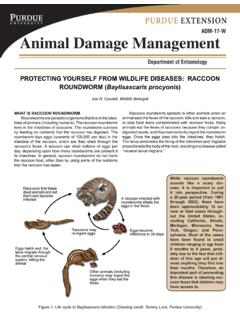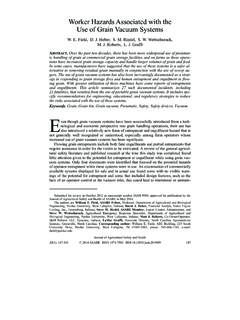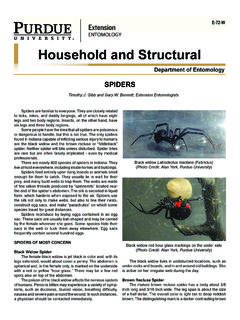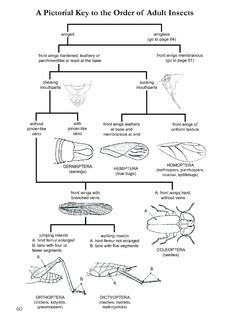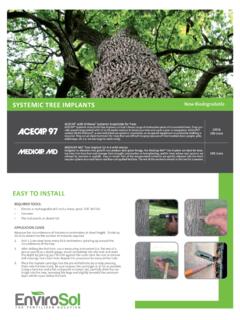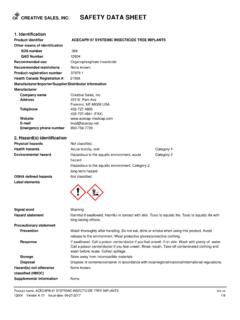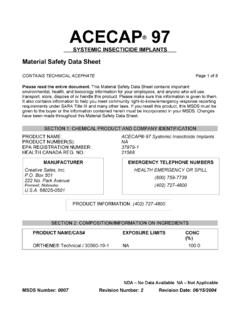Transcription of Section of Communications and Technology fact sheet
1 The Ohio State UniversityCollege of Food, Agricultural,and Environmental SciencesSection of Communications and Technologyfact sheetInsecticide Options for Protecting Ash Treesfrom Emerald Ash Borer and Their EffectivenessDaniel A. Herms and David J. Shetlar, Associate Professors, Department of Entomology, Ohio Agricultural Research and Development Center, and State Specialists, Ohio State University Extension, The Ohio State UniversityAmy K. Stone, Extension Educator, Ohio State University Extension, Lucas County, and Ohio State University Extension Emerald Ash Borer Outreach CoordinatorOhio State University Extension personnel have received many questions from homeowners and Green Industry profession-als wondering if there are insecticides capable of protecting ash trees from emerald ash borer (EAB).
2 Research and experi-ence have shown that insecticides can protect trees from EAB. However, success is not assured. Research suggests that best control will be obtained when treatments are initiated in the earliest stages of infestation before visible symptoms are present, or perhaps even the year before trees are infested. It is also important to realize that treatments will have to be repeated each year. In some cases, it may be more cost-effec-tive to remove and replace the has been much confusion surrounding the question of whether insecticides are an effective option for EAB. The an-swer is: It depends on the objective. When the objective is to protect trees from being killed, insecticides have been effec-tive.
3 However, when the objective is to eradicate an EAB infes-tation to keep it from spreading, insecticides are not effective, which is why they have not been used as an eradication tool by the Cooperative EAB Program. EAB is now firmly established in northwest Ohio and a number of isolated outlier infestations have been detected throughout the state. In response to these developments, members of the OSU Extension Nursery, Landscape, and Turf Team have developed the following recommendation regarding the use of insecticides for controlling EAB in Ohio:Ash trees within Ohio Department of Agriculture s EAB quarantine, as well as those outside the quarantine but within the vicinity ( 10-15 miles) of a known infestation, are considered to be at risk.
4 Annual insecticide treatments should be considered by those in these areas who want to try to protect their ash elsewhere in Ohio are not considered to be immediately threatened, but this will change as EAB spreads and new infestations are discovered, so it is important to stay up-to-date. Locations of infestations, current quarantine maps, and other information about EAB in Ohio can be found at the following websites: and people who elect to treat their trees, there are several insecticide options available. It is important to keep in mind that controlling wood-boring insects with insecticides has always been a difficult proposition.
5 This is especially true with EAB because our native North American ash trees have no natural resistance to this pest. In some university trials, insecticide treatments were effective, but in other trials the same treatments failed. Furthermore, in some studies conducted over multiple years, EAB infestations continued to increase despite ongoing treatment programs. Some arborists are combining treatments to increase the odds of success ( combining a cover spray with a systemic treatment). insecticide programs show promise, but research on chemical control of EAB is still in early stages. Scientists from universities, government agencies, and compa-nies are conducting intensive studies to understand the circumstances under which insecticide treatments will be most Options for Controlling EABI nsecticides used for control of EAB fall into three categories: (1) systemic insecticides that are applied as soil injections or drenches; (2) systemic insecticides applied as trunk injections or trunk implants ; and (3) protective cover sprays that are applied to the trunk, main branches, and (depending on the label) foliage.
6 insecticide for-mulations and application methods that have been evaluated for control of EAB are listed in Table 1. Some can be purchased and applied by homeowners. Others can be applied only by professional applicators. Strategies for their effective use are described below. It is important to note that pesticide labels and registrations change constantly, and can vary from state to state. It is the pesticide applicator s legal responsibility to read, under-stand, and follow all current label directions for the specific pesticide product being 1. insecticide options for professionals and homeowners for control of EABINSECTICIDE FORMULATIONACTIVE INGREDIENTAPPLICATION METHODTIMINGM erit (75WP, 75 WSP, 2F)
7 IMA-jet Imicide Pointer Inject-A-Cide B Astro Onyx Sevin SLTempo Professional Use ProductsImidaclopridSoil injection or drenchImidaclopridTrunk injection, Arborjet ImidaclopridTrunk injection, Mauget ImidaclopridTrunk injection, Wedgle Bidrin Trunk injection, Mauget PermethrinPreventive Bifenthrinbark and foliage Carbarylcover spraysCyfluthrinMid-April to mid-MayMid-May to mid-JuneMid-May to mid-JuneMid-May to mid-JuneMid-May to mid-June2 applications at 4 week intervals with the first when black locust is blooming (early May in southern Ohio and late May in northern Ohio)Bayer Advanced Tree & Shrub Insect ControlACECAP 97 SystemicInsecticide Tree ImplantsHomeowner ProductsImidaclopridSoil drenchAcephateTrunk implantMid-April to mid-MayMid-May to mid-JuneUsing Insecticides to Control EABSoil-applied systemic InsecticidesSystemic insecticides applied to the soil are taken up by the roots and translocated throughout the tree.
8 The most widely tested systemic insecticide for control of EAB is imidacloprid, which is available for use by profes-sional applicators and homeowners. Professional use formulations of soil-applied imidacloprid include Merit 75WP, Merit 75 WSP, and Merit 2F. The homeowner formulation of imidacloprid is Bayer AdvancedTM Tree & Shrub Insect Control. Additional formulations of imidacloprid with different brand names are also becoming imidacloprid formulations can be applied as a drench by mixing it with water and pouring it directly on the soil at the base of the trunk. The application rates for the homeowner and professional formulations of imida-cloprid are very similar ( and grams of active ingredient per inch of trunk diameter, respectively).
9 Soil drenches offer the advantage of requiring no special equipment to apply (other than a bucket or watering can). However, surface layers of organic matter, such as mulch or leaf litter, can bind the insecticide and reduce uptake. Before applying soil drenches, it is important to remove or pull back any mulch or dead leaves so the insecticide solution is poured directly on the mineral soil. Merit formulations can also be applied as soil injections, which require special equipment, but offer the ad-vantage of placing the insecticide directly into the root zone. Injections should be made only deep enough (2-3 inches) to place the insecticide under the turf or mulch layer.
10 Soil injections can be made either at the base of the trunk or on a grid pattern extending to the edge of the canopy. Recent studies have found that soil injec-tions made immediately adjacent to the trunk (within 6-18 inches) are more effective than those made on a grid pattern under the canopy. Density of fine roots is very high at the base of the trunk and declines quickly as you move away from the tree because large radial roots diverge like spokes on a wheel prior to branching into smaller roots that ultimately terminate in feeder roots. This pattern of root distribution can be clearly observed on trees that have been recently uprooted in a storm, or when taking soil cores under the canopy, many of which will be devoid of fine timing for imidacloprid soil injections and drenches is mid-April to mid-May (treat on the early side in southern Ohio and on the later side in northern Ohio), which allows the 4-6 weeks that are necessary for uptake and distribution of the insecticide before larvae begin to establish in mid- to late June.
